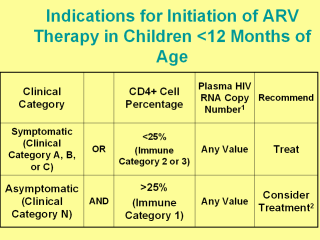| front |1 |2 |3 |4 |5 |6 |7 |8 |9 |10 |11 |12 |13 |14 |15 |16 |17 |18 |19 |20 |21 |22 |23 |24 |25 |26 |27 |28 |29 |review |
 |
This table provides general guidance rather
than absolute recommendations for an individual patient. Factors to be
considered in decisions about initiation of therapy include the risk of
disease progression as determined by CD4+ cell count and plasma HIV RNA copy
number; the potential benefits and risks of therapy; and the ability of the
caregiver to adhere to administration of the therapeutic regimen. Issues
associated with adherence should be fully assessed, discussed and addressed
with caregivers for the HIV-infected infant before the decision to initiate
therapy is made. ¹ Plasma HIV RNA levels are higher in HIV-infected infants than older infected children and adults, and may be difficult to interpret in infants <12 months of age because overall HIV RNA levels are high and there is overlap in HIV RNA levels between infants who have and those who do not have rapid disease progression. ² Because HIV infection progresses more rapidly in infants than older children or adults, some experts would treat all HIV-infected infants <6 months or <12 months of age, regardless of clinical, immunologic or virologic parameters. |